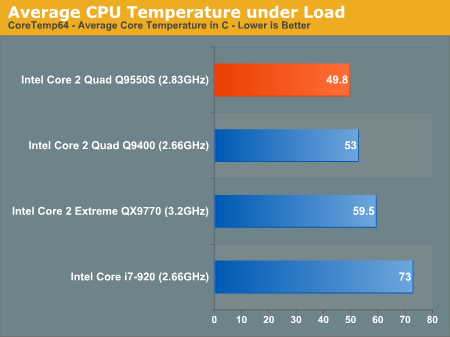Intel Core 2 Quad Q9550S: A New 65W Quad-Core
by Anand Lal Shimpi on January 27, 2009 8:00 PM EST- Posted in
- CPUs
Final Words: So Who Should Buy This Thing?
Over the past few pages of performance, power and efficiency graphs we’ve proved that the Q9550S offers lower power, but also lower efficiency than other Intel CPUs. In particular, the Core i7 is a far more power efficient processor thanks to its significant performance advantage. Then why on earth would anyone ever consider the Q9550S or any of the other new 65W parts for that matter?
The answer lies in the thermals. I took a few of the chips and used CoreTemp64 to record temperature data while running Prime95. I ran Prime95 for 10 minutes and averaged the temperatures of all four cores.

Remember the Core i7-920 that’s got such better power efficiency than the Q9550S? Well that doesn’t really matter if the CPU puts out too much heat. The i7-920’s cores got up to around 73C, the QX9770’s cores managed just under 60C while the Q9550S ran at a “cool” 49.8C.
For most users this doesn’t matter, the Core i7-920 would spend more time at idle (31.3C) than the Q9550S since it can complete tasks faster. Where this does matter however is if you’re running in a thermally constrained environment; for example, an all-in-one PC.
The Q9550S and the other 65W quad-cores are designed for OEMs or anyone trying to cram as much power into a very small space. I’d expect that these CPUs would be better suited for something like an iMac rather than a normal sized desktop. The problem is that in a normal desktop you’ve got more than enough room to keep even a Core i7 cool, but in some of these OEM designs (like the iMac or Dell XPS One 24) there’s hardly enough room for a normal heatsink and fan.
The S-series looks like it’s designed to allow OEMs to offer higher clocked quad-core CPUs in smaller form factors. If you’ve got a normal sized case however, there’s no reason to pay the price premium for one of these processors. If you do care about energy efficiency, you’d be much better off spending the extra $100 on a Core i7 system instead.










62 Comments
View All Comments
UltraWide - Wednesday, January 28, 2009 - link
why was a normal 95W TDP Q9550 not included???Anand Lal Shimpi - Wednesday, January 28, 2009 - link
I didn't actually have a 95W Q9550 available (Gary has the one we used in our Phenom II review). I provided the Q9650 and the Q9450 so you can get an idea of where the Q9550 would fall.Take care,
Anand
StraightPipe - Thursday, January 29, 2009 - link
I've got to agree with UltraWide.The news is Intel just came up with the S-line of procs.
But the test doesnt compare any S to non-S CPUs...
Isnt that what really matters? the perfomance and power consumption difference between the 95W and the new 65W is what I want to see.
anandtech02148 - Wednesday, January 28, 2009 - link
finally nice to see the pick and choose Anandtech bench, need to take it out of beta, save me a trip to tomshardware.Calin - Wednesday, January 28, 2009 - link
Those processors are perfect as replacements in servers already validated for the 95W version of the same processor. While buying i7 would be better, maybe the i7 servers weren't validated (remember the 3 years of support for business-related hardware lines)danchen - Wednesday, January 28, 2009 - link
looking at the numbers, it doesn't look like its worth the extra money.Its like buying an "environmentally friendly" car - high initial investment, takes many years to get an ROI.
perhaps if you're the type who runs your computers 24/7, it may actually save you some bills in the long run.
rpsgc - Wednesday, January 28, 2009 - link
Or... you could just undervolt your current CPU. Voilà.BTW, what is the default Vcore of these processors?
WillR - Wednesday, January 28, 2009 - link
Depends on the model, but I assume you mean the likes of the Q9550. Those are 1.22V.http://www.anandtech.com/cpuchipsets/showdoc.aspx?...">http://www.anandtech.com/cpuchipsets/showdoc.aspx?... shows a few.
lucassp - Wednesday, January 28, 2009 - link
"the publicly available x264 codec (open source alternative to H.264)"firstly x264 is only an encoder, and doesn't have an encoder included. x264 is an Open Source implementation of the H.264 standard. it's not an alternative to it.
lucassp - Wednesday, January 28, 2009 - link
sorry for the mistake, I meant to say it doesn't have a decoder included ;)